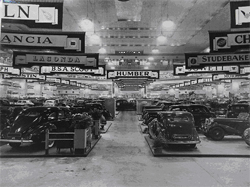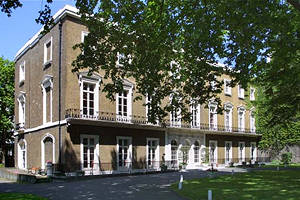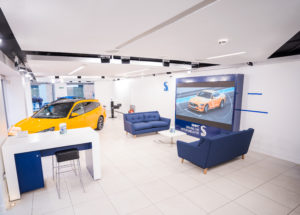Frederick Simms was a British engineer and pioneering visionary of today’s British motor industry. In 1902 he believed the fragmented nature of the UK’s motor industry needed to be addressed by creating a UK representative body to provide leadership, protection and direction to the British motor industry.
1902 to 1935
Industry leaders met to discuss issues affecting the UK’s automotive industry in February 1902, and on 22 July 1902, the Society of Motor Manufacturers and Traders (SMMT) was created and exists today as the leading trade body which supports and promotes the interests of the UK automotive industry at home and abroad.
Simms’ vision was that the SMMT would represent a “strong, influential and representative trade organisation, capable of encouraging, developing and protecting the new Industry in this country.”

Olympia – 1903
The principal aim of the Society was to exercise control over motor shows and the first SMMT exhibition was held at Crystal Palace in January 1903, then later moved to Olympia where it remained for 32 years.
Eighteen years after creation, SMMT activities were divided into five main classes:
- Legislative trade policy
- Control of exhibitions
- Races
- Automotive standards
- Contributions to charitable bodies
In 1926 a Statistical Information Department (SID) was established and in 1928 the Society’s first overseas representative was appointed, to be followed by the creation of a Garage Equipment section in 1930. SMMT’s activities abroad continued to expand and in April 1933 an overseas department was created.
1935 to 1945
The motor exhibitions at Olympia continued to attract large numbers each year, but in 1937 they were moved to the redeveloped Earls Court site. The outbreak of war 14 months later meant the Society’s focus changed dramatically. The cancellation of motor shows severely reduced income. Staff numbers were reduced and space vacated. Committee meetings were reduced to a minimum and the staff gave considerable assistance to government and its ministers.

Earls Court – 1937
In 1943, the Board of Trade asked SMMT to produce a report on the capacity, employment and capital equipment of the industry, so that the main problems to be faced at the end of the war might be known. Despite the depleted staff and the many pressures the industry faced in time of war, the detailed study was passed to government during 1944.
The lessons of war indicated that there was considerable research work to be done if the industry was to prosper in world markets, and in late 1945 the Motor Industry Research Association was formed.
1945 to 1980
The Motor Show and Commercial Vehicle Exhibition were re-introduced in October and November 1948. SMMT, the Smithfield Club and the Agricultural Engineers Association concluded an agreement to stage an annual exhibition at Earls Court from 1959. SMMT was very influential, with royalty and senior politicians of the day attending its shows.
During the 1950s, the industry continued its recovery from the immediate post-war period. In early 1956 over 500,000 people were directly employed in motor vehicle and parts production.
In late 1957, having moved from its Portland Street offices to 148 Piccadilly, SMMT was forced to look for new accommodation as its offices were being demolished to make way for a new road.
In January 1959 SMMT moved into Forbes House, Halkin Street.

Forbes House
In 1966, government and SMMT discussed a centralised vehicle registration system and in June 1969 the Vehicle Driving Licenses Act received Royal Assent (DVLA). SMMT would use the new licence documentation to provide the UK’s new vehicle registration statistics. In July 1972, the Motor Vehicle Registration Information System (MVRIS) began operating using part of the registration document.
Government announced in January 1970 that it supported the creation of a National Exhibition Centre in the Birmingham area and in September 1975 SMMT announced it would cease exhibiting at Earls Court after 1976 and that a combined car and commercial vehicle exhibition would be held at the National Exhibition Centre, Birmingham, in 1978.
1980 to 2010

The British International Motor Show returned to London, exhibiting at ExCeL in Docklands in 2006 and 2008.
2000 to present

The automotive industry is a vital part of the UK economy, and integral to supporting the delivery of the agendas for levelling up, net zero, advancing global Britain, and the plan for growth. It contributes £60 billion turnover and £12 billion value added to the UK economy, and invests around £3 billion each year in R&D. With more than 155,000 people employed directly in manufacturing and some 800,000 across the wider automotive industry, it accounts for 11% of total UK exports with more than 150 countries importing UK produced vehicles, generating more than £73 billion of trade.
More than 30 manufacturers build more than 70 models of vehicle in the UK, supported by more than 2,500 component providers and some of the world’s most skilled engineers. The automotive sector also supports jobs in other key sectors – including advertising, chemicals, finance, logistics and steel. Many of these jobs are outside London and the South-East, with wages that are around 25% higher than the UK average.









